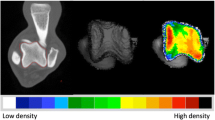Abstract
Objective
To test the anecdotal observation that isolated navicular collapse is associated with diabetes mellitus, we quantified the size of the tarsal navicular bone in subjects with and without diabetes and tested for association of size with age, height, weight, body mass index (BMI), gender, smoking, bone mineral density (BMD), duration, and level of control of diabetes.
Materials and Methods
Ankle radiographs of 200 patients (122 female; 78 male; mean age 58 years [27–89]), 100 with type II diabetes and 100 age- and gender-matched controls were selected and reviewed. The anteroposterior (AP) dimension of the mid-navicular bone was measured from lateral radiographs. For standardization, the supero-inferior (SI) dimension of the calcaneal was measured and the navicular–calcaneus ratio calculated. Statistical evaluation included independent sample t tests and linear regression analyses.
Results
Diabetic subjects had a significantly smaller navicular AP dimension and navicular–calcaneus ratio compared with controls (p = 0.02 and p = 0.0001 respectively). Age, gender, height and duration of diabetes had no association with the navicular–calcaneus ratio. The navicular–calcaneus ratio was inversely correlated with weight (p = 0.01) and BMI (p < 0.001) and directly correlated with smoking (p = 0.04). Reliability of the radiographic measurements was excellent (ICC 0.80–0.97; SEM 0.3–1.7 mm).
Conclusion
The anteroposterior dimension of the navicular is smaller in type II diabetic subjects than in age- and gender-matched controls. We hypothesize that this might be due to navicular collapse of multifactorial causes.

Similar content being viewed by others
References
Lesko P, Maurer RC. Talonavicular dislocations and midfoot arthropathy in neuropathic diabetic feet. Natural course and principles of treatment. Clin Orthop Relat Res. 1989;240:226–31.
Samarasinghe YP, Brunton SL, Feher MD. Avascular necrosis not Charcot’s. Diabet Med. 2001;18(10):846–8.
Scott-Moncrieff A, Forster BB, Andrews G, Khan K, et al. The adult tarsal navicular: why it matters. Can Assoc Radiol J. 2007;58(5):279–85.
Tosun B, Al F, Tosun A. Spontaneous osteonecrosis of the tarsal navicular in an adult: Mueller-Weiss syndrome. J Foot Ankle Surg. 2011;50(2):221–4.
Müller W. Über eine eigenartige doppelseitige Veränderung des Os naviculare pedis beim Erwachsenen. Dtsch Z Chir. 1927;1(2):84–9.
Haller J, Sartoris DJ, Resnick D, et al. Spontaneous osteonecrosis of the tarsal navicular in adults: imaging findings. AJR Am J Roentgenol. 1988;151(2):355–8.
Weiss K. Über die Malacie des Os naviculare pedis. Rofo. 1929;40:63–7.
Tominaga Y. Biomechanical analysis of the medial arch of the foot based on a rigid body spring model. Nihon Seikeigeka Gakkai Zasshi. 1994;68(9):774–83.
Golano P, Farinas O, Saenz I. The anatomy of the navicular and periarticular structures. Foot Ankle Clin. 2004;9(1):1–23.
Manter JT. Distribution of compression forces in the joints of the human foot. Anat Rec. 1946;96(3):313–21.
Isidro ML, Ruano B. Bone disease in diabetes. Curr Diabetes Rev. 2010;6(3):144–55.
Chin JA, Sumpio BE. Diabetes mellitus and peripheral vascular disease: diagnosis and management. Clin Podiatr Med Surg. 2014;31(1):11–26.
Torg JS, Pavlov H, Cooley LH, et al. Stress fractures of the tarsal navicular. A retrospective review of twenty-one cases. J Bone Joint Surg Am. 1982;64(5):700–12.
Conflict of interest
The authors declare that they have no conflict of interest.
Author information
Authors and Affiliations
Corresponding author
Rights and permissions
About this article
Cite this article
Harmouche, E., Robertson, D., Kogler, G. et al. Tarsal navicular bone size in diabetics: radiographic assessment. Skeletal Radiol 43, 969–972 (2014). https://doi.org/10.1007/s00256-014-1877-7
Received:
Revised:
Accepted:
Published:
Issue Date:
DOI: https://doi.org/10.1007/s00256-014-1877-7




